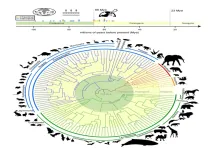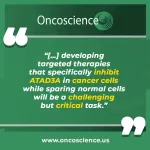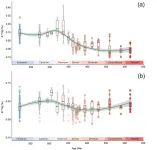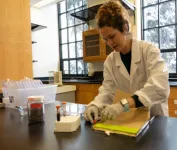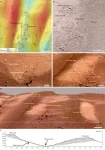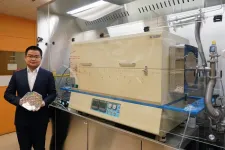(Press-News.org) The human body relies heavily on electrical charges. Lightning-like pulses of energy fly through the brain and nerves and most biological processes depend on electrical ions traveling across the membranes of each cell in our body.
These electrical signals are possible, in part, because of an imbalance in electrical charges that exists on either side of a cellular membrane. Until recently, researchers believed the membrane was an essential component to creating this imbalance. But that thought was turned on its head when researchers at Stanford University discovered that similar imbalanced electrical charges can exist between microdroplets of water and air.
Now, researchers at Duke University have discovered that these types of electric fields also exist within and around another type of cellular structure called biological condensates. Like oil droplets floating in water, these structures exist because of differences in density. They form compartments inside the cell without needing the physical boundary of a membrane.
Inspired by previous research demonstrating that microdroplets of water interacting with air or solid surfaces create tiny electrical imbalances, the researchers decided to see if the same was true for small biological condensates. They also wanted to see if these imbalances sparked reactive oxygen, “redox,” reactions like these other systems.
Appearing on April 28 in the journal Chem, their foundational discovery could change the way researchers think about biological chemistry. It could also provide a clue as to how the first life on Earth harnessed the energy needed to arise.
“In a prebiotic environment without enzymes to catalyze reactions, where would the energy come from?” asked Yifan Dai, a Duke postdoctoral researcher working in the laboratory of Ashutosh Chilkoti, the Alan L. Kaganov Distinguished Professor of Biomedical Engineering and Lingchong You, the James L. Meriam Distinguished Professor of Biomedical Engineering.
“This discovery provides a plausible explanation of where the reaction energy could have come from, just as the potential energy that is imparted on a point charge placed in an electric field,” Dai said.
When electric charges jump between one material and another, they can produce molecular fragments that can pair up and form hydroxyl radicals, which have the chemical formula OH. These can then pair again to form hydrogen peroxide (H2O2) in tiny but detectable amounts.
“But interfaces have seldom been studied in biological regimes other than the cellular membrane, which is one of the most essential part of biology,” said Dai. “So we were wondering what might be happening at the interface of biological condensates, that is, if it is an asymmetric system too.”
Cells can build biological condensates to either separate or trap together certain proteins and molecules, either hindering or promoting their activity. Researchers are just beginning to understand how condensates work and what they could be used for.
Because the Chilkoti laboratory specializes in creating synthetic versions of naturally occurring biological condensates, the researchers were easily able to create a test bed for their theory. After combining the right formula of building blocks to create minuscule condensates, with help from postdoctoral scholar Marco Messina in? Christopher J. Chang’s group at the University of California – Berkeley, they added a dye to the system that glows in the presence of reactive oxygen species.
Their hunch was right. When the environmental conditions were right, a solid glow started from the edges of the condensates, confirming that a previously unknown phenomenon was at work. Dai next talked with Richard Zare, the Marguerite Blake Wilbur Professor of Chemistry at Stanford, whose group established the electric behavior of water droplets. Zare was excited to hear about the new behavior in biological systems, and started to work with the group on the underlying mechanism.
“Inspired by previous work on water droplets, my graduate student, Christian Chamberlayne, and I thought that the same physical principles might apply and promote redox chemistry, such as the formation of hydrogen peroxide molecules,” Zare said. “These findings suggest why condensates are so important in the functioning of cells.”
“Most previous work on biomolecular condensates has focused on their innards,” Chilkoti said. “Yifan’s discovery that biomolecular condensates appear to be universally redox-active suggests that condensates did not simply evolve to carry out specific biological functions as is commonly understood, but that they are also endowed with a critical chemical function that is essential to cells.”
While the biological implications of this ongoing reaction within our cells is not known, Dai points to a prebiotic example of how powerful its effects might be. The powerhouses of our cells, called mitochondria, create energy for all of our life’s functions through the same basic chemical process. But before mitochondria or even the simplest of cells existed, something had to provide energy for the very first of life’s functions to begin working.
Researchers have proposed that the energy was provided by thermal vents in the oceans or hot springs. Others have suggested this same redox reaction that occurs in water microdroplets was created by the spray of ocean waves.
But why not condensates instead?
“Magic can happen when substances get tiny and the interfacial volume becomes enormous compared to its volume,” Dai said. “I think the implications are important to many different fields.”
This work was supported by the Air Force Office of Scientific Research (FA9550-20-1-0241, FA9550-21-1-0170) and the National Institutes of Health (MIRA R35GM127042; R01EB029466, R01 GM 79465, R01 GM 139245, R01 ES 28096).
CITATION: “Interface of Biomolecular Condensates Modulates Redox Reactions,” Yifan Dai, Christian F. Chamberlayne, Marco S. Messina, Christopher J. Chang, Richard N. Zare, Lingchong You, Ashutosh Chilkoti. Chem, April 28, 2023. DOI: 10.1016/j.chempr.2023.04.001
END
Previously unknown intercellular electricity may power biology
Newly discovered electrical activity within cells could change the way researchers think about biological chemistry
2023-04-28
ELSE PRESS RELEASES FROM THIS DATE:
Texas A&M research redefines mammalian tree of life
2023-04-28
Research led by a team of scientists from the Texas A&M School of Veterinary Medicine and Biomedical Sciences puts to bed the heated scientific debate regarding the history of mammal diversification as it relates to the extinction of the non-avian dinosaurs. Their work provides a definitive answer to the evolutionary timeline of mammals throughout the last 100 million years.
The study, published in Science, is part of a series of articles released by the Zoonomia Project, a consortium of scientists from around the globe that is using the largest mammalian genomic dataset in history to determine the evolutionary history of the human genome in the context of mammalian evolutionary history. ...
Twelve outstanding journalists named 2023 MBL Logan Science Journalism Fellows
2023-04-28
WOODS HOLE, Mass. –Twelve accomplished science and health journalists have been awarded a highly competitive fellowship in the Logan Science Journalism Program at the Marine Biological Laboratory (MBL).
Now in its 36th year, the Logan Science Journalism Program provides journalists with immersive, hands-on research training, giving them invaluable insight into the practice of science as well as some of the major news stories of today. The program, which offers a Biomedical course and an Environmental course, will run May 30-June 9 in Woods Hole.
Biographies ...
Improved gene editing method could power the next generation of cell and gene therapies
2023-04-28
PHILADELPHIA— A new approach to the genetic engineering of cells promises significant improvements in speed, efficiency, and reduction in cellular toxicity compared to current methods. The approach could also power the development of advanced cell therapies for cancers and other diseases, according to a study from researchers in the Perelman School of Medicine at the University of Pennsylvania.
In the study, which appeared this week in Nature Biotechnology, researchers found that protein fragments used by some viruses to help them get into cells could ...
ATAD3A: A molecular determinant favoring head and neck cancer development
2023-04-28
“[...] developing targeted therapies that specifically inhibit ATAD3A in cancer cells while sparing normal cells will be a challenging but critical task.”
BUFFALO, NY- April 28, 2023 – A new research perspective was published in Oncoscience (Volume 10) on April 4, 2023, entitled, “Mitochondrial regulator ATAD3A: a molecular determinant favoring head and neck cancer development.”
In addition to their role in energy metabolism, mitochondria play important roles in other cellular processes, such as apoptosis, calcium signaling and the synthesis of certain biomolecules. Mitochondria have also been ...
Vascular plants colonized land extensively by the early Silurian: Study
2023-04-28
The colonization and expansion of plants on land represent a defining landmark for the path of life on Earth. Terrestrial colonization has been attributed to a series of major innovations in plant body plans, anatomy, and biochemistry that transformed global biogeochemical cycles and climates.
It is crucial to identify the onset and track the expansion of those earliest land plants. However, the precise timing of land colonization by vascular plants remains controversial due to the sparseness of early land plant megafossils, poor stratigraphic controls ...
Machine learning helps scientists identify the environmental preferences of microbes
2023-04-28
Researchers have figured out a way to predict bacteria’s environmental pH preferences from a quick look at their genomes, using machine learning. Led by experts at the University of Colorado Boulder, the new approach promises to help guide ecological restoration efforts, agriculture, and even the development of health-related probiotics.
“We know that in any environment, there’s a ton of bacteria with important ecological functions, but their environmental preferences often remain unknown,” said Noah Fierer, a fellow of the Cooperative Institute for Research in Environmental ...
Tianwen-1: Zhurong Rover finds evidence of water at low latitudes on modern Mars
2023-04-28
The Zhurong rover has found evidence of water on dune surfaces on modern Mars by providing key observational proof of liquid water at low Martian latitudes, according to a study led by Prof. QIN Xiaoguang from the Institute of Geology and Geophysics (IGG) of the Chinese Academy of Sciences (CAS).
The study was published in Science Advances on April 28.
Researchers from the National Astronomical Observatories of CAS and the Institute of Atmospheric Physics of CAS were also involved in the study.
Previous ...
Looking for insights from our nearest star-forming galaxy
2023-04-28
Vallia Antoniou, an assistant professor of practice in the Department of Physics and Astronomy at Texas Tech, has been awarded observing time on the powerful Chandra X-Ray Telescope to explore some of the deepest recesses of the universe.
It marks the second major Chandra program led by Antoniou, who is also a research associate with the Smithsonian Astrophysical Observatory.
Each year, astronomers from around the world follow a rigorously competitive process to receive Chandra time. The telescope was launched aboard the space shuttle Columbia in 1999 and orbits Earth, offering previously unavailable views of deep space at wavelengths that are not accessible from ground telescopes. During ...
MIT engineers “grow” atomically thin transistors on top of computer chips
2023-04-28
CAMBRIDGE, MA — Emerging AI applications, like chatbots that generate natural human language, demand denser, more powerful computer chips. But semiconductor chips are traditionally made with bulk materials, which are boxy 3D structures, so stacking multiple layers of transistors to create denser integrations is very difficult.
However, semiconductor transistors made from ultrathin 2D materials, each only about three atoms in thickness, could be stacked up to create more powerful chips. To this end, MIT researchers have now demonstrated a novel technology that can effectively ...
How solid air can spur sustainable development
2023-04-28
The green hydrogen economy is a sustainable alternative to fossil fuels. However, one of the challenges of constructing a global hydrogen economy is hydrogen transportation by sea. A new paper proposes solid air as a medium for recycling cold energy across the hydrogen liquefaction supply chain.
The world is undergoing an energy transition to reduce CO2 emissions and mitigate climate change. The COVID-19 pandemic and the Russia-Ukraine war have further increased the interest of Europe and Western countries to invest in the hydrogen economy as an alternative to fossil fuels. Hydrogen can significantly reduce geopolitical risks ...
LAST 30 PRESS RELEASES:
Injectable breast ‘implant’ offers alternative to traditional surgeries
Neuroscientists devise formulas to measure multilingualism
New prostate cancer trial seeks to reduce toxicity without sacrificing efficacy
Geometry shapes life
A CRISPR screen reveals many previously unrecognized genes required for brain development and a new neurodevelopmental disorder
Hot flush treatment has anti-breast cancer activity, study finds
Securing AI systems against growing cybersecurity threats
Longest observation of an active solar region
Why nail-biting, procrastination and other self-sabotaging behaviors are rooted in survival instincts
Regional variations in mechanical properties of porcine leptomeninges
Artificial empathy in therapy and healthcare: advancements in interpersonal interaction technologies
Why some brains switch gears more efficiently than others
UVA’s Jundong Li wins ICDM’S 2025 Tao Li Award for data mining, machine learning
UVA’s low-power, high-performance computer power player Mircea Stan earns National Academy of Inventors fellowship
Not playing by the rules: USU researcher explores filamentous algae dynamics in rivers
Do our body clocks influence our risk of dementia?
Anthropologists offer new evidence of bipedalism in long-debated fossil discovery
Safer receipt paper from wood
Dosage-sensitive genes suggest no whole-genome duplications in ancestral angiosperm
First ancient human herpesvirus genomes document their deep history with humans
Why Some Bacteria Survive Antibiotics and How to Stop Them - New study reveals that bacteria can survive antibiotic treatment through two fundamentally different “shutdown modes”
UCLA study links scar healing to dangerous placenta condition
CHANGE-seq-BE finds off-target changes in the genome from base editors
The Journal of Nuclear Medicine Ahead-of-Print Tip Sheet: January 2, 2026
Delayed or absent first dose of measles, mumps, and rubella vaccination
Trends in US preterm birth rates by household income and race and ethnicity
Study identifies potential biomarker linked to progression and brain inflammation in multiple sclerosis
Many mothers in Norway do not show up for postnatal check-ups
Researchers want to find out why quick clay is so unstable
Superradiant spins show teamwork at the quantum scale
[Press-News.org] Previously unknown intercellular electricity may power biologyNewly discovered electrical activity within cells could change the way researchers think about biological chemistry
